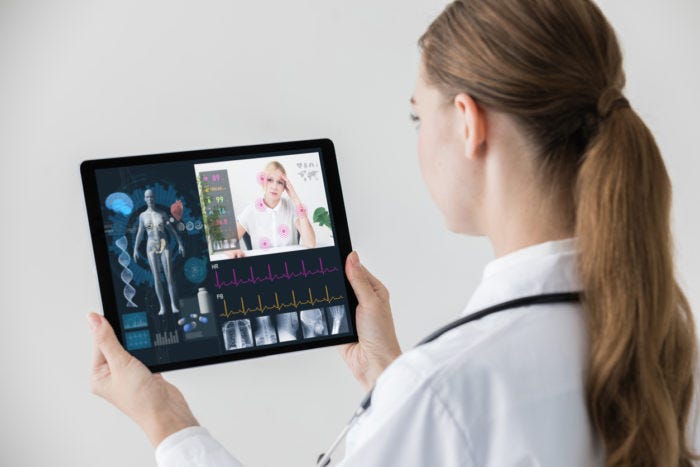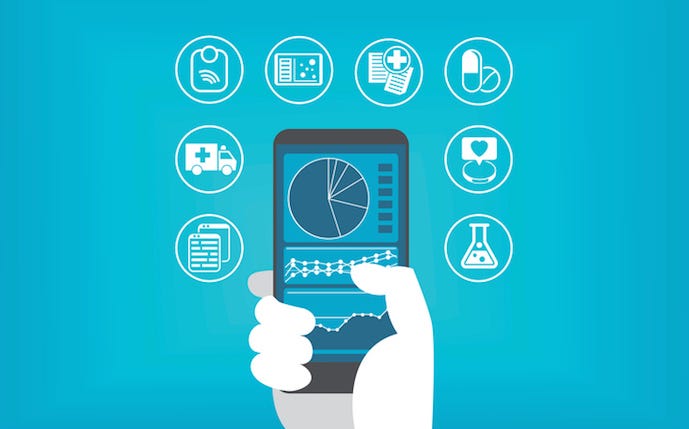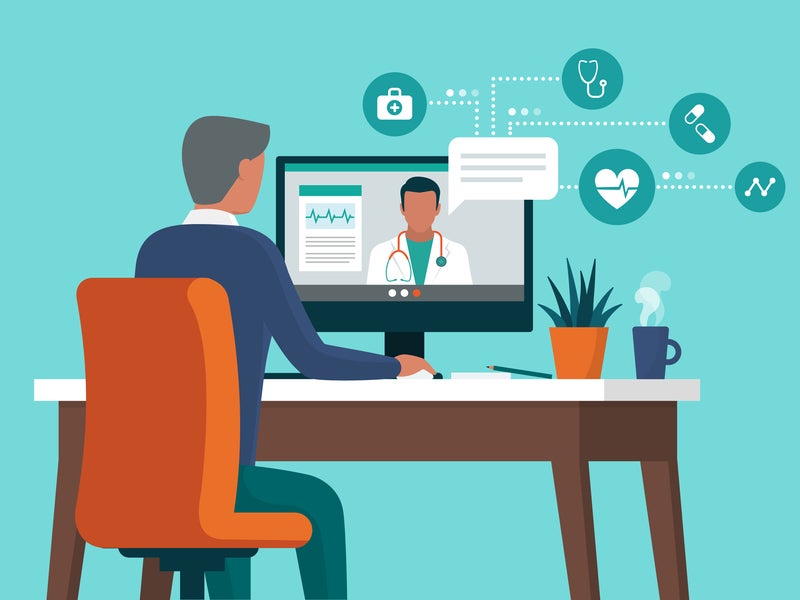The Covid-19 pandemic heralded a rapid transformation of the analog clinical care paradigm into the digital age, accelerating a previously nascent market of new modalities of care delivery, payment models, and regulatory reform that has the promise to unlock innovation in health care.
NEJM Catalyst
Bimal R. Shah, MD, MBA and Kevin Schulman, MD
March 30, 2021
medcitynews
Summary
The novel coronavirus complex-19 (Covid-19) created an unprecedent upheaval in a matter of weeks in the United States.
Overnight, hospitals shuttered elective procedures and outpatient services and rapidly shifted to telehealth visits as regulators temporarily lifted federal and statutory restrictions, increased payment for virtual visits on par with in-person visits, and removed co-payments for telehealth visits.
The transformation of care turned telehealth from a novelty into an expectation for the future.
Innovation has thrived during the pandemic and accelerated adoption of new care through the convergence of emerging businesses and strategies.
As such, this market disruption enabled a nascent group of start-ups a true opportunity to transform fee-for-service and episodic care into a patient-centric, continuously available, personalized, and readily convenient service analogous to how technology has transformed entertainment, news, retail, and banking in recent decades.
… this market disruption enabled a nascent group of start-ups a true opportunity to transform fee-for-service and episodic care into a patient-centric, continuously available, personalized, and readily convenient service analogous to how technology has transformed entertainment, news, retail, and banking in recent decades.
However, the adoption of new technologies, the testing of new business models, and the opportunity to accelerate a move to value-based care run the risk of sputtering if regulators and entrenched incumbents push to dial these learnings back to pre-pandemic norms.
In the current article, we explore the underpinnings of telehealth and the convergence of new applications of data collection, personalization, and business models that have the opportunity to redefine health care services for the next decade and beyond.
However, the adoption of new technologies, the testing of new business models, and the opportunity to accelerate a move to value-based care run the risk of sputtering if regulators and entrenched incumbents push to dial these learnings back to pre-pandemic norms.
Table of Contents (TOC)
- Crisis Mode
- Virtual Care Defined
- Virtual Care as the Disruptor
- The Catalyst for Disruption
- Early Marketplace Evolution
- The Virtual Clinic
- The Virtual Clinic Will See the Patient Now
- Table Stakes for Virtual Care
- The Fee-for-Service Productivity Trap
- Washington, D.C.’s Opportunity
- Seizing the Moment
Crisis Mode
On January 20, 2020, when the first U.S. case of novel coronavirus complex-19 (Covid-19) was reported, few could have predicted the profound and rapid impact the global pandemic would have on the delivery of health care.
Within weeks of the pandemic spreading across the country, facilitated by the rapid response of regulatory and payment bodies, almost every health system and provider had shut down elective surgery and outpatient visits and had converted the latter into telehealth interactions.
The pace of this immediate pivot was unprecedented in modern health care, with almost half of all Medicare primary care visits being provided through telehealth in April 2020, compared with 0.10 of 1% in February 2020, before the Public Health Emergency (PHE) was declared.
This shift led Seema Verma, the head of the U.S. Centers for Medicare & Medicaid Services (CMS), to declare: “I think the genie’s out of the bottle on this one.
I think it’s fair to say that the advent of telehealth has been just completely accelerated, that it’s taken this crisis to push us to a new frontier, but there’s absolutely no going back . . . [b]ut this, to me, is the most clear example of untapped innovation.”
I think it’s fair to say that the advent of telehealth has been just completely accelerated, that it’s taken this crisis to push us to a new frontier, but there’s absolutely no going back . . . [b]ut this, to me, is the most clear example of untapped innovation.”

Virtual Care Defined
According to CMS, telehealth and telemedicine “generally refer to the exchange of medical information from one site to another through electronic communication to improve a patient’s health.”
Telehealth is a modality or setting of care and not a specific type of care.
Telehealth services can be used to connect individuals to an individual health care provider or to a health care system (such as Kaiser Permanente and Geisinger, among others).
Telehealth can involve synchronous interactions (via telephonic, videoconferencing, or synchronous or asynchronous text-based chats) to supplement or replace traditional face-to-face clinical care.
The first reported telehealth visits were applications for military use, specifically in the early 1990s, when the U.S. Military Health Service extended specialty care from fixed bases to deployed forces, such personnel on ships, with the added benefit of lower costs.
The first reported telehealth visits were applications for military use, specifically in the early 1990s, when the U.S. Military Health Service extended specialty care from fixed bases to deployed forces, such personnel on ships, with the added benefit of lower costs.
Over the past 25 years, wider adoption and diffusion of telehealth has been propelled by advances in telecommunications infrastructure and capacity, such as high-speed Internet and broadband data services, data encryption standards for audio and video communications, and miniaturization of sensors.
Over the past 25 years, wider adoption and diffusion of telehealth has been propelled by advances in telecommunications infrastructure and capacity, such as high-speed Internet and broadband data services, data encryption standards for audio and video communications, and miniaturization of sensors.
But rather than spark a revolution in care, these advances have been encumbered by policy and regulatory restrictions (such as statuary licensure requirements and limitations of scope of practice), low reimbursement rates coupled with high technology costs, and physician resistance resulting from the perception of loss of professional autonomy.
But rather than spark a revolution in care, these advances have been encumbered by policy and regulatory restrictions (such as statuary licensure requirements and limitations of scope of practice), low reimbursement rates coupled with high technology costs, and physician resistance resulting from the perception of loss of professional autonomy.
Remote patient monitoring (RPM) is the subset of telehealth that allows for instantaneous or batched collection, transmission, evaluation, and communication of patient-generated data from an individual to the care team.
RPM includes a wide and rapidly expanding array of wired and wireless devices such as implantables, biosensors, blood pressure cuffs, weight scales, glucometers, and pulse oximetry, as well as sensors that collect data passively (e.g., sleep mats, wrist-worn sensors, video cameras, floor mats) and smartphones.
RPM allows continuous and longitudinal monitoring of chronic diseases, and early evaluations have shown the opportunity to save costs in the care of patients with chronic conditions.
Increasingly, RPM solutions are bundled with wider services to allow for (1) the transmission and storage of user-collected data into cloud storage,
(2) the use of emerging technologies (e.g., artificial intelligence [AI] and machine learning) to enhance disease surveillance and early detection, and
(3) improved diagnosis and personalized care. To date, RPM has made inroads in many direct-to-consumer applications (e.g., AliveCor, Apple Watch, OneDrop, etc.).
The application of RPM in health care has lagged beyond ambulatory cardiac rhythm monitoring, largely because of outdated reimbursement strategies that are based on time spent reviewing remote monitoring data, workflow requirements (including electronic medical record integration), and patient barriers associated with co-payment requirements.
Remote patient monitoring (RPM) is the subset of telehealth that allows for instantaneous or batched collection, transmission, evaluation, and communication of patient-generated data from an individual to the care team.
Collectively, telehealth and remote monitoring (whether integrated or not) are generally referred to as virtual care as neither requires an individual to walk into a traditional urgent care clinic, emergency room, office clinic, or hospital to receive clinical monitoring or care.
Collectively, telehealth and remote monitoring (whether integrated or not) are generally referred to as virtual care as neither requires an individual to walk into a traditional urgent care clinic, emergency room, office clinic, or hospital to receive clinical monitoring or care.
Prior to the pandemic, these services were largely separate …
Prior to the pandemic, these services were largely separate, limiting the ability of each to fully service high-complexity or chronic conditions such as those requiring monitoring through biometric sensors (e.g., oxygen saturation, heart rate or rhythm, temperature, blood pressure).

Virtual Care as the Disruptor
The first enabler, simplifying technology, was widely available in the form of inexpensive biosensors and smartphones, cloud computing for storage and real-time analytical processing, and ubiquitous connectivity through Bluetooth, Wi-Fi, or cellular. In terms of the “Jobs to Be Done” framework described by Christensen, these technologies could help to optimize business processes in health care or even substitute for some clinical interactions with providers.
The first enabler, simplifying technology, was widely available in the form of inexpensive biosensors and smartphones, cloud computing for storage and real-time analytical processing, and ubiquitous connectivity …
Disruption of the traditional health care business model did not occur on the scale seen in other consumer services and other markets.
Disruption of the traditional health care business model did not occur on the scale seen in other consumer services and other markets.
The second enabler, a disruptive value network, had been emerging for the better part of the decade and was slowly gaining traction.
These value networks were created by entirely new classes of companies that began to deliver health services alongside the incumbents but were not reliant on the traditional value chain for service delivery (e.g., hospitals, health plans, pharmacy benefit providers).
The second enabler, a disruptive value network, had been emerging for the better part of the decade and was slowly gaining traction.
Value disruptors included telehealth providers (e.g., Teladoc Health, Doctor on Demand, 98point6, CirrusMD), digital health services (e.g., Livongo, Omada, Hinge Health, Propeller, Cricket), pharmacy services (e.g., GoodRx, Trupill, PillPack, Ro, Hims), providers (e.g., Crossover Health, VillageMD, OneMedical), and health plans (e.g., Oscar, Clover, Collective Health, Bright) that were built from the ground up by providing services through new value networks and a prominent focus on consumer experience.
By delivering modularized components of clinical services to specific populations, using technology as the foundational infrastructure to deliver care, developing new marketplaces to sell services (e.g., smartphone applications), and/or leveraging new payment models for differentiation, the goal of these disruptive organizations is to provide improved outcomes at costs that are lower than traditional care.
In many cases, the simplifying technologies and new value networks were one and the same or were on a slow path to converging prior to the emergence of Covid-19.
The second enabler, a disruptive value network, had been emerging for the better part of the decade and was slowly gaining traction.
Many of these value-disruption players had innovative business models, especially around the financing of care.
For example, some had established membership-based fee models, some worked to align risk structures for costs and outcomes, and some took full risk for patient outcomes.
However, disruption of the traditional health care business model did not occur on the scale seen in other consumer services and other markets.
Telehealth services could not meet all of the clinical demands of patients, and, as a result, telehealth coexisted with traditional care models.
Many of these value-disruption players had innovative business models, especially around the financing of care.
Telehealth services could not meet all of the clinical demands of patients, and, as a result, telehealth coexisted with traditional care models.
The practical necessity of leveraging existing provider organizations for the purpose of developing comprehensive telehealth solutions serves as a barrier to the disruption of existing value networks in the market.
The incumbent players, protected by regulatory and reimbursement constructs that had not been updated for new technologies or care models, further limited the penetration of new care models that conflicted, or even competed, with existing business models.
The incumbent players, protected by regulatory and reimbursement constructs that had not been updated for new technologies or care models, further limited the penetration of new care models that conflicted, or even competed, with existing business models.
The Catalyst for Disruption
Overnight, with the Covid-19 pandemic, we observed a huge shift in the market.
These innovative technologies, disruptive value networks, and new business models became highly relevant as public concerns about the safety of in-person visits and inherent Covid-19 risk emerged.
Policymakers and payers quickly acted to eliminate payment models that served as barriers to telehealth — for example, by eliminating co-pays and allowing for reimbursement for telehealth visits on par with in-person visits.
On the regulatory side, the Office for Civil Rights at the Department of Health & Human Services announced that it would use its enforcement discretion and not impose penalties for Health Insurance Portability and Accountability Act (HIPAA) violations related to telehealth during the emergency, removing what had become a major barrier to innovation in health care.,
Other regulatory barriers also were suspended, including state licensure barriers that restricted access to out-of-state providers, and CMS eliminated the requirement of having an established physical provider for telehealth services.
With the adoption of these policies and removal of these barriers to innovation, telehealth exploded.
The swift increase resulted in an attitudinal shift by providers and patients that would have naturally taken 5–10 years or longer at its former trajectory.
With the adoption of these policies and removal of these barriers to innovation, telehealth exploded.
The German economist Joseph Schumpeter noted, “as a rule the new does not grow out of the old but appears alongside of it and eliminates it competitively.”
Novel virtual care and technology-enabled care models are developing outside of traditional health care companies.
Yet, given the vertical and horizontal integration of health care markets, these models generally cannot stand alone.
Thus, in the commercial market, their potential efficiency is blunted by health systems’ pricing models for specialty services.
However, in the Medicare Advantage market, novel virtual care models have access to the Medicare fee schedule for out-of-network services, providing an opportunity for potentially more robust testing of this concept.
What was once perceived to be a niche set of services on the fringe has become recognized as a new expectation in health care delivery.
During the first Covid-19 peak in the U.S. (starting in mid-to-late March 2020), the awareness of telehealth services grew from just over 50% to 75% of the population in just 5 weeks.
Now, more than three-quarters of Americans
Additionally, research has indicated that up to one-third of U.S. adults would leave their current physician for a provider who offered telehealth access.
On the supply side, after being forced into using the new technology as a result of the crisis, two-thirds of providers are now more comfortable using telehealth and are hopeful that the meaningful easing of regulatory and reimbursement requirements for virtual care will become permanent beyond the PHE.
On the supply side, after being forced into using the new technology as a result of the crisis, two-thirds of providers are now more comfortable using telehealth and are hopeful that the meaningful easing of regulatory and reimbursement requirements for virtual care will become permanent beyond the PHE.
Early Marketplace Evolution
In March and April 2020, health systems and commercial telehealth players rapidly scaled their infrastructure and services to enable physicians to simply conduct a video or telephonic visit.
The clinical content of the visit generally allowed for the maintenance of chronic care as well as some ability to evaluate the emergence of new symptoms or concerns.
In March and April 2020, health systems and commercial telehealth players rapidly scaled their infrastructure and services to enable physicians to simply conduct a video or telephonic visit.
However, in most cases, these visits were devoid of data such as vital signs, recent laboratory information …
However, in most cases, these visits were devoid of data such as vital signs, recent laboratory information (in cases in which the telehealth provider was not the usual source of care), or other biometric information required to provide more advanced services such as starting or titrating new therapies, recommending further diagnostics, or assessing the risk of progression necessitating more advanced care.
The optimization of virtual care requires more than the ability to have a video chat with a patient.
The requirements to enable virtual care include both advances in technical capacity to integrate patient data into the visit and the ability to optimize virtual visits in a system of care.
The optimization of virtual care requires more than the ability to have a video chat with a patient.
Furthermore, regardless of whether clinicians are providing care synchronously or asynchronously, efficiency occurs when these individuals are performing at “top of the license” of the care process.
As the understanding of the need to couple telehealth with remote monitoring devices and services developed, there was a flurry of activity to bring these capacities together to enable true virtual care.
This demand was exemplified by the $18.5 billion merger between Teladoc, a leading global telehealth provider, and Livongo, the leading remote monitoring service for chronic conditions.
This merger announcement was swiftly followed by other significant activity in the telehealth space, with Doctor on Demand raising an additional $50 million of private funding, Amwell issuing its IPO backed by a $100 million investment from Google Cloud, MDLive being acquired by Cigna, and a number of other remote monitoring companies (e.g., Omada, Virta) receiving significant additional investment.
This financial activity continues to spread across the health care digital and virtual ecosystem and currently shows no signs of slowing or maturing, suggesting that existing players will continue to evolve with scale and new entrants will have financial momentum to seek new areas to disrupt.

The Virtual Clinic
Coupled with enhanced software-enabled analytics, virtual care is being further enabled by a new generation of sensor, device, and diagnostic technologies.
Small, highly sensitive devices for continuous monitoring are becoming increasingly available to measure oxygen saturation, body surface temperature, heart rate, heart sounds, and electrocardiograms.
Handheld devices for echocardiography coupled with AI are opening new opportunities for diagnostic imaging that an individual could perform outside a traditional clinic (e.g., Butterfly) as well as other devices that provide high resolution of auscultative waveforms (e.g., Eko).
Home blood and urine-testing kits and solutions for creatinine monitoring, HbA1c, lipids, and blood chemistry profiles also help to unshackle patients from the inconvenience and time spent driving back to a clinic or hospital for blood-based monitoring.
Small, highly sensitive devices for continuous monitoring are becoming increasingly available to measure oxygen saturation, body surface temperature, heart rate, heart sounds, and electrocardiograms.
The Virtual Clinic Will See the Patient Now
As software and hardware advances coincide with the rapid acceptance of telehealth care by both physicians and patients, a number of other factors will have to align to continue the innovation and persistence of new virtual care paradigms.
First, as data are collected on the outcomes and benefits of telehealth, there are a number of open questions on
(1) whether and how to assess the evidence on the basis of appropriateness-of-care modalities and
(2) when telehealth and remote monitoring models should be leveraged for specific conditions. These questions have both clinical and economic implications, and the answers may be different depending on the underlying payment model.
Clinically, understanding
(1) which conditions lend themselves easily to virtual, remote, and/or asynchronous care and
(2) how and where relevant data will or can be collected are ongoing research and operational questions.
Simultaneously, there should be an understanding of
(1) when and how traditional, episodic, in-person care is required;
(2) how in-person and virtual care services complement each other; and
(3) how telehealth and remote monitoring data should be leveraged in both of these contexts.
Answers to these questions can be seen as the “secret sauce” of a novel telehealth organization or a health care system such as Kaiser, which actively leveraged this technology before Covid-19.
Such business model transformations continue to be hindered by considerations related to the site of care, the required level of provider, or the payment model endorsed and protected by professional societies and medical boards.
These barriers only serve to support inefficient incumbent business models in a market that witnessed rapid transformation with technology forced by a pandemic.
While telehealth may not fully lend itself to all clinical situations and conditions, many chronic conditions lend themselves to a virtual model of care.
While telehealth may not fully lend itself to all clinical situations and conditions, many chronic conditions lend themselves to a virtual model of care.
For example, consider a young woman with lone atrial fibrillation. Her routine visits to a cardiologist could be completely virtualized, with the basic components of a “visit” (e.g., vital signs, symptom review, medication review) being deconstructed and reimagined for virtual care. In this case, different strategies are deployed to collect the different data elements.
For example, remote devices can readily capture vital signs such as heart rate and blood pressure. Concurrently, patient symptoms and medication review can be easily captured with a mobile phone app.
Finally, electrocardiogram (ECG) monitoring can be conducted with the increasing proliferation of a number of clinically validated handheld or wearable sensors devices that transmit 2-lead information (required for heart rate and rhythm analysis). ]
Any change in symptoms could prompt a quick review of remote ECG data. If it was determined that new-onset heart failure may be contributing to her symptoms, a home-based echocardiogram evaluation could be easily obtained through an AI-enabled handheld device connected to a smartphone to guide a home health assistant or other trained professional in obtaining the necessary sonographic windows.
This type of interaction would provide increased convenience for the patient, provide a faster assessment than waiting to get an echocardiogram scheduled at her local hospital or clinic, and could be cheaper than a typical echocardiogram due the technology requirements and the use of nontechnical staff.
This type of interaction would provide increased convenience for the patient, provide a faster assessment than waiting to get an echocardiogram scheduled at her local hospital or clinic, and could be cheaper than a typical echocardiogram due the technology requirements and the use of nontechnical staff.
Application of this model would require a physical encounter with a clinician only when specific signs or symptoms reach a threshold that identify the need for more complex investigation and diagnostics, thus allowing physicians and other clinical staff (such as nurses, nurse practitioners, or physician assistants) to practice at the top of their credentials, allowing for more efficient care by matching patients to the optimal care provider and site of care.
Application of this model would require a physical encounter with a clinician only when specific signs or symptoms reach a threshold that identify the need for more complex investigation and diagnostics,…
Use cases such as the one described above are pervasive in clinical medicine and specifically in the care of patients with chronic conditions.
Furthermore, the virtual care ecosystem is gaining momentum on how to apply the best care models for different patient groups to drive both efficiency and outcomes.
Furthermore, the virtual care ecosystem is gaining momentum on how to apply the best care models for different patient groups to drive both efficiency and outcomes.
In terms of high-touch service, both physical and virtual health care require empathy and compassion.
Physicians are often the recipient of a patient’s most intimate details about their health, highlighting their personal vulnerability in ways that they may not share with their spouse, family, or friends.
The cornerstone of effective health care is trust, and this must be considered a cornerstone of any technology-based solution in the health sector.
In terms of high-touch service, both physical and virtual health care require empathy and compassion.
Table Stakes for Virtual Care
In this vision, data are no longer assets for competitive advantage in health care, but rather are the prerequisite “table stakes” to power new insights and new models of care.
However, the data architecture and business models that are needed to support the integration of all of these data streams into an accessible data resource is lacking.
Furthermore, HIPAA continues to serve as a barrier for facilitating frictionless exchange of information.
These obstacles are related to HIPAA’s ambiguity in terms of the regulation or its enforcement (leading to risk-averse legal and compliance opinions within organizations) or as part of an “information blocking” business strategy where health entities view health care data as an asset to monetize for competitive advantage.
Five years after the 21st Century Cures Act called for restrictions on information blocking by providers, CMS finally released new rules to address this practice (although the implementation was delayed for several additional months).24
Five years after the 21st Century Cures Act called for restrictions on information blocking by providers, CMS finally released new rules to address this practice (although the implementation was delayed for several additional months).24
At the same time, data collection has moved from provider and payer entities to consumers themselves with apps and biosensors
At the same time, data collection has moved from provider and payer entities to consumers themselves with apps and biosensors.
HIPAA does not apply to consumer uses of their own data, and, as such, there is an emerging path to a rich data ecosystem that is consumer-based and governed by consumer data privacy laws rather than HIPAA.
Unfortunately, privacy advocates with genuine concern about data privacy and security have called for expansion of the HIPAA regulatory scheme to these new data sources — an effort that could erect a further barrier to innovation in health care and could result in a conflict between regulatory schemes for health data and more general consumer privacy legislation.
Machine learning data techniques have been the parlance of numerous consumer-centric business models over the past decade as many companies have started to use advanced self-learning analytics to drive various aspects of their internal business models.
Machine-learning models are pervasive throughout the consumer technology world and are used to facilitate engagement and drive product utilization; examples include personalized advertising placement on Google and Facebook and content recommendations on Netflix and Amazon.
These models are starting to diffuse into health care technology companies to drive the same behaviors.25
Enabling marketing or engagement algorithms requires a large number of users, detailed profiles of their habits and preferences, and a platform such as a mobile phone or some other means of delivering the content (e.g., tablet, voice-enabled assistant, monitoring device, connected eyewear, Web screen, etc.).
Machine learning data techniques have been the parlance of numerous consumer-centric business models over the past decade as many companies have started to use advanced self-learning analytics to drive various aspects of their internal business models.
Many health technology companies are starting to reach the scale at which this information-gathering and application is possible.
The use cases for leveraging these data can include the personalization of messaging to motivate individuals to enroll in these programs and to facilitate behavioral change while at the same time supporting a positive feedback loop driving usage of the services and platform.
The use cases for leveraging these data can include the personalization of messaging to motivate individuals to enroll in these programs and to facilitate behavioral change while at the same time supporting a positive feedback loop driving usage of the services and platform.
The Fee-for-Service Productivity Trap
As virtual care reconstructs the notional view of how health care is delivered and received, the fee-for-service payment model also will have to evolve to support a care model that is available 24–7, allowing for care to be delivered synchronously and asynchronously.
An acceleration to value-based per-employee per-month payment models has been the de facto model in the chronic care market, but payers and employers are increasingly reluctant to pay blanket fees for those who do not receive care or those who seek alternative venues of care.
In response, we have seen the development of per-member/patient per-month case-rate structures that align to when a person is being monitored and using a service — which, interestingly, is a refresh of the case-rate or episode-based capitation models resulting from disease management concepts from the 1990s.,
Additionally, these fee structures can be incorporated into risk agreements, thereby driving access, usage, clinical outcomes, and even cost savings that further align value to payment.
Some virtual care companies have even started to examine taking capitated risk for an entire population of individuals with a single chronic (or even acute) condition directly from self-insured employers and health plans.
Alongside well-documented disparities in risk brought forth by Covid-19, recent studies have warned of disparities in access to the benefits of telehealth.
Washington, D.C.’s Opportunity
For this vision to be successful, government will have to continue its role as an enabler of change. Many of the reimbursement and regulatory changes adopted during the Covid-19 crisis were designated as temporary.
Many of these changes had been proposed for years and lacked an evidence base of benefit to drive action against the risk of potential harm. Now that these changes have occurred, the approach should be the opposite, and these barriers should only resume if there is clear evidence of inferior care.
Despite decades of concern over the risks of virtual medicine, there have been no reports of wide-scale privacy violations or fraud that should limit our progress in this space.
We should continue to look for evidence of such adverse impacts but should maintain the policy changes in the meantime as one of the small benefits of this crisis.
It is too early to conclude what federal, state, and commercial reimbursement and payment model changes that were made to address the Covid-19 pandemic will be retained after the PHE.
Extending the payment parity between in-person and telehealth visits would continue to enable the innovation in telemedicine that has accelerated as a result of the pandemic.
Over the past 12 months, we have seen virtual care innovation accelerate in maturity within the health care market (and can provide a significant research and evaluation opportunity as a result).
An intriguing question is how CMS can use its authorities under the fee schedule and through the Centers for Medicare & Medicaid Innovation (CMMI) to construct further tests of telemedicine constructs.
It will be important to develop payment models that consider both technology and professional services and that can be applied to a variety of care settings, from prevention to ambulatory care to chronic care.
These models can be developed in both fee-for-service and value-based or capitated payment frameworks.
Concurrently, building and testing new quality measures for clinical care that reflect technology-enabled services should be part of the effort to drive to patient-centric outcomes.
Alongside well-documented disparities in risk brought forth by Covid-19, recent studies have warned of disparities in access to the benefits of telehealth.
Innovators have started to inexpensively build cellular service connectivity into their products and pricing models.
Yet a more aggressive approach to supporting the telehealth infrastructure can have benefits beyond the health sector.
Health care services need access to reliable broadband connectivity or smartphone connectivity to ensure that the evolution of care delivery touch the lives of all equally.
Financial support for this infrastructure could easily come from health insurance savings if virtual care can be shown to reduce per-patient costs.
Establishing this level of connectivity could have benefits for other sectors, such as education or industries that enable remote work in our new economy.
Alongside well-documented disparities in risk brought forth by Covid-19, recent studies have warned of disparities in access to the benefits of telehealth.
Yet a more aggressive approach to supporting the telehealth infrastructure can have benefits beyond the health sector.

Seizing the Moment
The nation has been transformed by the pandemic.
The virtual care experience that has evolved as a response to Covid-19 has accelerated the public and professional experience of the role of technology in the health care system of the future.
The pandemic has demonstrated that there is a latent capacity for innovation inherent in the market.
Now that it has been unleashed, we can begin to envision both the full potential of the technology and the potential threat to existing business models.
Patients feel empowered with new ways to obtain care at their convenience and are moving forward with the expectation that, in the future, virtual care will be as simple as banking or shopping on their phones.
Conversely, no one running a health care system or an insurer wants to be the leader of a record company in a streaming music world, and so there will be great pressure to constrain the genie or to close Pandora’s Box.
Patients feel empowered with new ways to obtain care at their convenience and are moving forward with the expectation that, in the future, virtual care will be as simple as banking or shopping on their phones.
The evolution of clinical delivery models is at a crossroads in terms of supporting the further development of this model.
The virtual care industry is still facing an uphill battle as health care systems drive to restore their proven pre-pandemic business model.
The evolution of clinical delivery models is at a crossroads in terms of supporting the further development of this model.
The virtual care industry is still facing an uphill battle as health care systems drive to restore their proven pre-pandemic business model.
Regulators, policymakers, and commercial payers can simply revert numerous provisions relaxed and bypassed for regard of the PHE back to pre-Covid-19 policies.
Regrettably, this action would simply close the door on the exciting new ways to think about a consumer-centric, virtually enabled care delivery model that could improve health and reduce costs.
Providers fearful of losing revenue from site-of-service charges, lower payments in value-based arrangements, or complete loss of patients to integrated virtual care providers could mobilize to restrict innovation in care delivery, as they have done in the past.
The health care market has the opportunity to embrace the challenge to make health care better and not squander the opportunity that the pandemic has provided.
Originally published at https://catalyst.nejm.org on March 30, 2021.
About the authors
Bimal R. Shah, MD, MBA
Chief Medical Officer,
Teladoc Health, Purchase, New York, USA;
Adjunct Assistant Professor,
Duke University School of Medicine, Durham, North Carolina, USA
Kevin Schulman, MD
Professor of Medicine, Department of Medicine,
Stanford University, Stanford, California, USA
TAGS: Telehealth; RPM; Virtual Care; Virtual Clinic; Disruptive innovation; Digital Acceleration; Value Based Payment; Data Sharing; Covid-19












